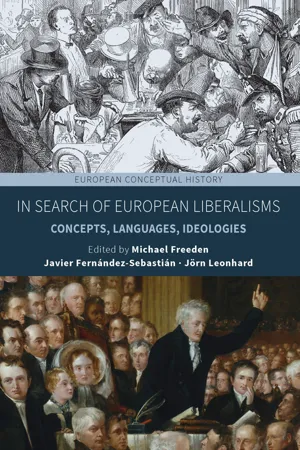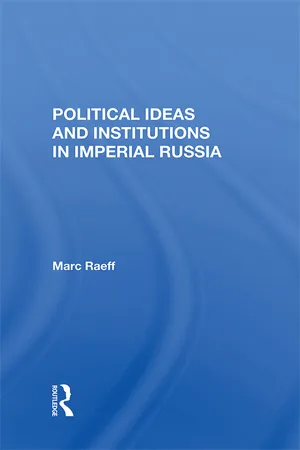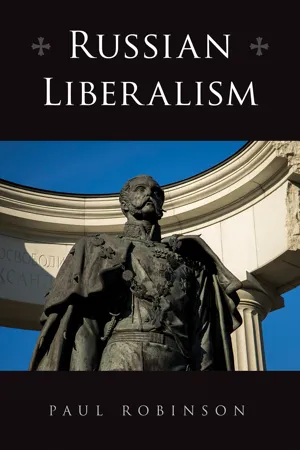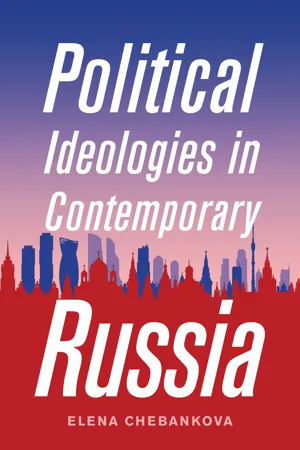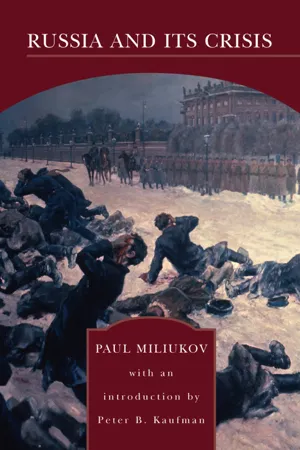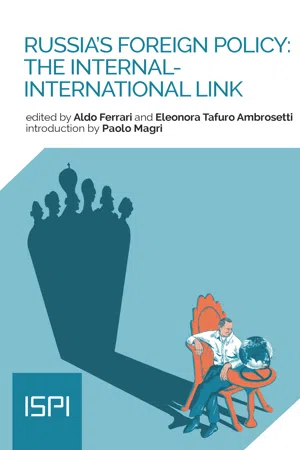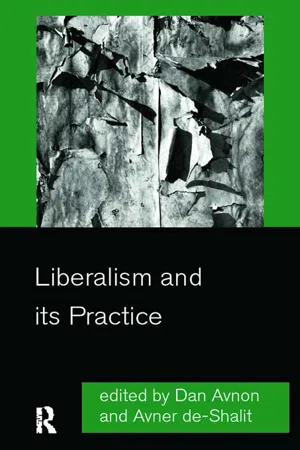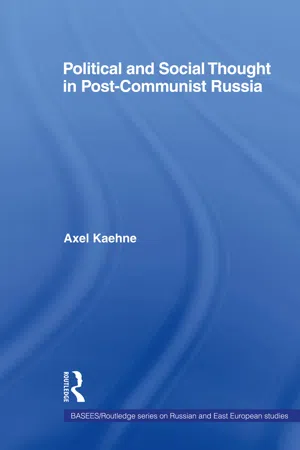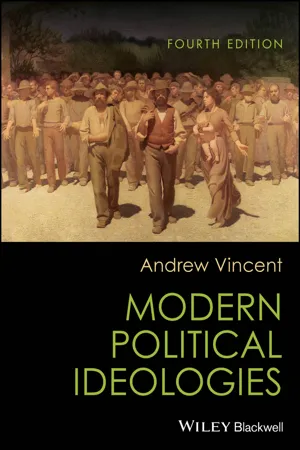History
Liberalism in Russia
Liberalism in Russia refers to the political ideology that emerged in the 19th century, advocating for individual freedoms, constitutional government, and free-market economy. It gained momentum during the late imperial and early Soviet periods, but faced significant challenges and restrictions under authoritarian rule. Despite its fluctuations, liberalism has continued to influence political discourse and movements in Russia.
Written by Perlego with AI-assistance
Related key terms
Related key terms
1 of 4
Related key terms
1 of 3
11 Key excerpts on "Liberalism in Russia"
- eBook - ePub
In Search of European Liberalisms
Concepts, Languages, Ideologies
- Michael Freeden, Javier Fernández-Sebastián, Jörn Leonhard, Michael Freeden, Javier Fernández-Sebastián, Jörn Leonhard(Authors)
- 2019(Publication Date)
- Berghahn Books(Publisher)
Chapter 10
Encounters with Liberalism in Post-Soviet Russia
Olga MalinovaDespite the fact that the concept ‘liberalism’ had a significant history in Russia in the nineteenth and early twentieth centuries,1 its reappearance in political practice during perestroika and after the collapse of the Soviet Union should be considered as essentially a new stage in its semantic evolution. As we shall see later, some particular meanings associated with the term before 1917 finally became salient in the post-Soviet period as well. At the same time, there were significant differences that indicate a break in semantic continuity.According to research conducted by Mikhail Kalashnikov, the French term idées libérales appeared in the lexicon of the Russian educated elite at the very beginning of the nineteenth century, and the concept ‘liberalism’ as a label for constitutionalist political practices took shape around 1816–19.2 However, the meaning of the term remained vague, which allowed its application to rather different ideas and groups that vaguely resembled their counterparts in Western Europe; this was often the reason for denying the ‘authenticity’ of Russian liberalism. Because of this ambiguity, there is no common opinion regarding the starting point of Russian liberalism as a particular set of social and political ideas. Those who use this term in a broad sense move it back in time to the middle of the eighteenth3 or the beginning of the nineteenth centuries.4 Others take as a benchmark the preparation of reforms in the 1860s.5 Many scholars identify the beginnings of the intellectual history of Liberalism in Russia with conceptions developed in the 1840–50s by intellectuals affiliated with the Westernizers’ (zapadniki ) circle – Timofey Granovsky, Konstantin Kavelin and Boris Chicherin.6 Liberal political parties appeared in Russia in 1905, during the first revolution, when they were legalized. There were two major liberal parties – the Constitutional Democrats Party (formally the Party of People’s Freedom, informally the Kadets) and the Union of the 17th of October (informally the Oktiabrists) – and several smaller ones. None of them used the word ‘liberal’ in the party name because due to its discrepant connotations, it could not be a trustworthy label.7 - Marc Raeff(Author)
- 2019(Publication Date)
- Routledge(Publisher)
2Soviet historiography does not recognize alternative paths of historical development, it is not interested in the "vanquished." To the extent that it has dealt with "liberalism" (and for that matter conservatism, too)—as it had to for a full history of Russian revolutionary movements and ideas—it has treated liberalism as a set of isolated ideas or events which never combined into a meaningful pattern or trend. Such limited one-sidedness could not satisfy Western historiography as it implied a vae victis mentality alien to its humanistic search for truth and historical understanding.3 This circumstance has contributed in determining an essential characteristic of recent work in the West on Russian liberalism: liberalism was a possible alternative to revolutionary radicalism. Hence, most efforts have been directed at distinguishing liberalism from radicalism, at drawing a sharp and meaningful boundary so that liberalism could not be confused with revolutionary extremism or radicalism. But in their effort at distinguishing liberalism from the "left," historians have neglected the equally important task of setting it off from the "right," from conservatism.4 If individuals and ideologies are to be categorized it should be on the basis of rather clear and universally acceptable criteria. I am perfectly well aware that this is not an easy matter. While in the nineteenth century—in Russia as well as in the West—the term liberal had a very specific connotation in contrast to reaction, the distinction has become blurred in our days as a result of our experience with "totalitarian democracy." Whereas the boundaries between liberalism and radicalism had been shadowy and mobile in the nineteenth century, those between conservatism and liberalism were drawn sharply and rigidly. But today the reverse is true. A very sharp distinction is now made between traditional liberalism and the revolutionary radicalism which emerged from late eighteenth century enlightenment and utopianism.5 It is no accident that in recent decades the study of liberal thought has led to a positive reappraisal of conservatism and stressing of liberalism's indebtedness to the juridical and spiritual tradition of the Ständestaat. 6 This popularity of conservatism in Western historiography is matched nowadays by the great interest in conservative figures and movements among Russian historians in the United States, England, and Germany.7- Paul Robinson(Author)
- 2023(Publication Date)
- Northern Illinois University Press(Publisher)
54These differing conclusions flow naturally from the different definitions of liberalism chosen by the authors in question. So too do the conclusions of modern Russian historians. Perhaps out of a sensitivity to the complaint that liberalism is a Western import without deep roots in Russian society, Russian scholars have sought to expand the definition of liberalism to include as large a group of people and ideas as possible. To this end, they start with the person (lichnost’) as the focus of liberal thought, and stress the principle of personal freedom.55 “The problem of the status of the Person is the central problem of liberalism,” writes Shelokhaev, adding that liberalism’s aim is to maximize peoples’ ability to fulfill their potential.56 “Liberalism in all its manifestations is a doctrine defending the freedom of the person,” agree Lidiia Novikova and Irina Sizemskaia.57With the definition of liberalism limited largely to the person and to personal freedom, the door is open to include within the parameters of Russian liberalism a huge spectrum of people and ideas. Anybody who was, or is, in some way committed to the value of the person and personal freedom fits within the definition. This is the case even if they imagined that the interests of the person could best be served by the application of principles and institutions other than those mentioned above. Aleksei Kara-Murza’s huge encyclopedia of Russian liberal “Ideas and People” contains biographies of a vast range of figures, including some usually considered deeply conservative (such as Karamzin and the journalist Mikhail Katkov [1818–1897]); Slavophiles (such as Ivan Aksakov [1823–1886]); radicals and revolutionaries (such as Herzen); bureaucrats (such as Nikolai and Dmitry Miliutin [1818–1872 and 1816–1912, respectively]); and others whom one might more obviously expect to find in a list of Russian liberals (such as certain members of the Kadet Party).58- eBook - ePub
- Elena Chebankova(Author)
- 2020(Publication Date)
- McGill-Queen's University Press(Publisher)
LiberalismRussian liberalism is often studied, understood, and presented through the prism of the radical-liberal opposition, the views of which may be equally appealing and disturbing to commentators, depending on their political preferences. Yet activists and thinkers of the radical-liberal opposition, though espousing liberal ideas, could not meaningfully claim the right to speak on behalf of Russia’s liberal school of thought. This chapter argues that contemporary Russian liberalism must be studied through the prism of two competing trends – moderate pluralist and monistic radical. The discussion will briefly cover some of the main aspects of the monistic tradition but will mainly focus on the pluralist trend of Russian liberalism, as this intellectual current is under-represented in Western media and academic debate. The discussion suggests that, due to political temperance and a nuanced approach to Russia’s socio-political realities, this trend of Russia’s liberalism is more promising and conducive to the entrenchment of the liberal idea in Russia.Before going any further, it is important to note that the division of liberalism into different groupings is not unique to Russia. Ideological and tactical disagreements within liberal practice are also significant in the West. Bearing in mind that Russian political thought is derived from its Western counterpart, it seems feasible to discuss the main divisions within the Western liberal trend and then search for an echo of these debates in Russia. This approach will determine the chapter’s structure. The first section will discuss the two competing faces of the Western liberal tradition, while the following two sections will examine the nature of ideological discourse within the Russian moderate-pluralist and radical-monistic liberal trends, with a particular emphasis on the pluralist tradition. - Paul Miliukov(Author)
- 2009(Publication Date)
- Barnes & Noble(Publisher)
Now, in Russia the meaning of the term “liberalism” is at once extended and worn out. It is extended to the more radical groups, particularly in the press, for the simple reason that every more advanced term would be provoking to the censor and thus would incur prompt suppression. The original meaning of liberalism was the more easily altered, because in Russia it was not bound by any historical recollections. It connoted the idea of state intervention, and thus became more democratic, without being inconsistent with a former tradition. General ideas are easily changed, if they remain abstract, not being embodied in any system of actual party policy. At the same time, however, the term “liberalism” is worn out in Russia. This, of course, is not because the liberal program is already realized. Far from being so, this program presents now the first step to be attained; and this is recognized and accepted by all parties in Russia. But, of course, this first step is not acknowledged to be the only one: political freedom and individual liberty no longer seem to be the absolute good that they were considered when the era of liberty dawned in France. In the eyes of subsequent generations, libralism was rather discredited as a sort of class policy, that of the “third estate,” and thus anti-democratic. This was the meaning of the term, which was already largely accepted and current in Russia long before any continuous liberal policy could be outlined. The greater number of such as call themselves liberals in Russia in fact hold to the more advanced opinions. That is why the term, as I said, is worn out, without having actually served. It certainly will not stand the slightest strain. With the first gust of political liberty it will yield to some more advanced term, while it will probably remain in use to designate some conservative group.We may now see the difference between the liberalism of Russia and that of western Europe. But we shall not be able clearly to understand the reasons for this difference unless we resort to a historical explanation. This is chiefly to be sought in the different structure of the Russian society from that of western Europe.It is well known that European liberalism originated in the struggle of the bourgeoisie — the wealthy and enlightened middle class of city inhabitants — with an absolute monarchy and the privileged landed proprietors. Russia, however, did not possess such a bourgeoisie as that of western Europe, and such as it did possess was neither wealthy nor enlightened, nor numerous and influential enough to have any political weight in the country. To be sure, in Russia, too, liberalism was directed against the agrarian class of landlords, and particularly against their right to possess serfs. But it was started by members of the same class of agrarian gentry and nobility, and the promoters of the movement, far from supporting the class interests, undermined the social position of the nobility and destroyed the very source of their political power. In doing so they were, of course, guided, not by class considerations, but by philanthropic feelings and advanced political theories. Thus they represented, not class opinion, but general public opinion. Russian liberalism was not bourgeois, but intellectual- eBook - ePub
Russia's Foreign Policy
The Internal-International Link
- Aldo Ferrari, Eleonora Tafuro Ambrosetti(Authors)
- 2021(Publication Date)
- Ledizioni(Publisher)
155 The Basic Tenet of LiberalismThe Russian liberal has long been a two-pronged creature, and this has manifested itself over the decades. On the one hand, Russian liberalism was something special. The emigrant publicist Nikolai Osipov wrote in the Munich almanac Mosty (Bridges ) in 1959 about the main features of Russian liberals of this specific kind: “Not bourgeois individualism was at its core, not Adam Smith, not the slogan of free trade, but humanity and the people”.156 And at the same time, the Russian liberal was both entrepreneur and reformer, above all economic (what was called Manchester-type liberalism): “Only businessmen could raise the era of great reforms, and in the combination of idealism, high culture and great practical acumen they expressed the type of Russian liberal”.157 Russian liberalism finally took shape by the end of the XIX century, even though the liberal journal Vestnik Evropy (European messenger ) in 1895 attributed the absence of bourgeois Liberalism in Russia to the absence of bourgeoisie in the Western European sense of the word.158The type of liberal who believes, in today’s terms, in authoritarian modernisation from above emerged in nineteenth-century Russia. “The basic dogma of liberalism” (N. Osipov) of this statist type proceeded from the following assumption: “Reforms can be carried out only through the union of the autocracy and the liberal minority of society against the interests and desires of the majority of that society”.159 All attempts at reforms in the XIX century were based on this logic, which included compromises, half-reforms, and failures that turned into counter-reforms.160 The dilemma of the despotic reformer has been known since the XVIII century. It is the problem of Catherine II – how to maintain autocracy and a hierarchical social system, while at the same time carrying out reforms and imposing education?161 - eBook - ePub
State against Civil Society
Contentious Politics and the Non-Systemic Opposition in Russia
- Cameron Ross(Author)
- 2017(Publication Date)
- Routledge(Publisher)
At the same time, both these groups managed to reach some consensus on base fundamental values within their respective segments. The traditionalist–conservative group shares the baseline consensus assumption that the history, culture, political culture, internal energy, and unique creativity of the Russian people must determine the country’s political evolution independently from any potential external influence. This faction repels the idea of ‘straightjacketing’ Russia into foreign, and primarily Western, developmental models. Mikhail Delyagin, a left-wing opposition economist, claims that people need:the renaissance of Russian civilization based on our own particular identity, hidden and washed out during the lifetime of the entire generation. Previous developments have shown that Russian civilisation cannot be built on the basis of identities borrowed from outside. At the Valdai Forum Putin named the ultra-liberal model of development as unacceptable, thus undermining all the attempts to shoehorn the country back into the 1990s in the framework of the liberal perestroika-2 project. (Delyagin 2013a)The Russian liberal tradition, on the other hand, builds on the ideas of Peter the Great, who strove to emulate Western political and economic systems and thus achieve Russia’s modernisation and development. This strand of thought, though also very diverse, shares the political liberalism consensus of the West, and generally feels positive about the convergence of values on the liberal ground.One may rightly argue that the proposed pluralistic division fails to build a nuanced picture. People migrate between these value baskets and may, depending on circumstances, affiliate with each one of them at some point of their life. Moreover, while assessing Peter and his liberal posterity, we should remember that he also exhibited strong nationalistic tendencies, and, while attempting to adapt the Western idea of the good life to the Russian context, remained Russia’s ardent defender, focused on consolidating the country’s great power positions in military conflicts and in opposition to other European powers. Some Russian liberals also hold this line. Furthermore, contemporary traditionalist–conservatives often stand in stark opposition to the extant political elite led by Vladimir Putin, and, as mentioned above, this ideological camp is extremely diverse, being composed of democrats, and proponents of a strong or minimalist state, as well as supporters of left- or right-wing ideologies. Finally, the ideological disposition of the elite is also mixed and includes representatives from both spectra. - eBook - ePub
- Dan Avnon, Avner De-Shalit, Dan Avnon, Avner De-Shalit(Authors)
- 2012(Publication Date)
- Routledge(Publisher)
Not only do times change, needless to say, but some times change more spectacularly than others. Big Brother has been swept off the map, and we can no longer lend sharp contours to our basic principles and practices by contrasting them favorably to the unrealistic ideals and repressive behavior of a living totalitarian foe. Their closed society no longer teaches us, with colorful illustration, the true merit of our open society. Their concentra-tion of authority and subjugation to government no longer helps justify and explain our diffusion of authority and autonomy from government. True, the planet continues to breed illiberal political systems and move-ments. But the anti-liberal scene is now hopelessly cluttered, and we are not yet at loggerheads with any single dominant nationalism or authoritarianism or fundamentalism in a world-historical struggle to decide the fate of mankind. As the sole surviving superpower, therefore, we no longer know who we are not.As an exercise in self-knowledge, therefore, I propose a somewhat nostalgic thought experiment. Perhaps liberalism has as much to learn about itself from communism's aftermath as it once believed it had to learn from communism itself. If we re-survey the American system against the backdrop of Russian society today, what principles and practices, what norms and institutions, call special attention to themselves? On the surface, at least, this is a promising line of inquiry. For Russia, despite the radical loosening up it has recently undergone, remains an illiberal state in most respects. So what can the new Russian illiberalism, by way of contrast, teach us about ourselves? By answering this question, we might conceivably recover some insights about liberal politics that the now out-of-date contrast to Soviet tyranny once led us, justifiably or not, to neglect.Contemporary Russian illiberalism, I should say at the outset, is not principally a matter of nationalism.1 - Axel Kaehne(Author)
- 2007(Publication Date)
- Routledge(Publisher)
The view of a state that contributes actively to the creation of society is by no means limited to those on the extreme right or left (in any case these co-ordinates on the ideological spectrum carry a different meaning in Russia, given the Soviet legacy). Writing on the liberal reforms earlier in the twentieth century, Shelokhaiev (1996) notes that liberals worked with two assumptions that proved disastrously wrong: first, that the Russian state somehow did not represent any particular social group or was the vehicle for maximising the interests of any political camp (hence claiming that it was, in effect, classless); and second, that the intelligentsia acted as a coherent group of individuals which was ‘estateless’, that is to say not driven by the advancement of any particularistic interest. Ideally, so the reformers thought, the state and the intelligentsia could be merged and propel the modernising agenda of Russia without social revolution (Shelokhaiev 1996:30). As the state is assigned the task of initiating the social programme, it adopts the central unifying role in the creation of a future modern Russian society. In this perspective, there is no room for secession rights or even the articulation of interests defined by ethnic and national differences. The unitary statism that accords central competences to the state apparatus in the creation of society therefore has long and eminent roots and is echoed in the post-Communist period in Yegor Gaidar’s work State and Evolution (Gaidar 1995). In a roundtable discussion (Roundtable 2005), several eminent scholars take up the challenge of defining more clearly the contours of statism in Russia. The most pressing dilemma within the Russian context has always been to identify the exact boundaries of legitimate state intervention in society- eBook - ePub
- Andrew Vincent(Author)
- 2023(Publication Date)
- Wiley-Blackwell(Publisher)
Some scholars, for example, identify liberalism in the context of the history of nation states. German, Italian, Spanish, French and British liberalisms developed in unique political and socio‐cultural environments. The push for national unification in Italy or Germany in the nineteenth century, the effects of the 1789 revolution in France and the comparative isolation of Britain tempered the character of liberalism in these countries. There is thus no overarching European agreement on the nature of liberalism, rather different national traditions. While there is some truth to this, it can be over‐emphasized. As the authors of a recent synoptic text, which deals sympathetically with such liberal diversity across Europe, concede that because the concept liberal comprises ‘sufficiently intertwined semantic elements for those to be considered components of the “same” concept’ (Freeden and Fernández‐Sebastián 2019, 3). Thus liberalism, despite different national interpretations, can still be considered a consistent current of European thought. Another approach focuses on the character of liberal ideological traditions. The more standard path here is to argue for a distinction between Continental and Anglo‐American or British liberalisms (see Hayek 1978, 119; also Gray 1986a, x). The latter branch of liberalism is often seen to be of greater antiquity and more empirical in character. Continental liberalism is associated with the more fervid use of rationalism in human affairs. Any coherence here therefore lies in the two distinct traditions. Each is located within distinct cultural histories. This distinction can, in some cases, become narrowed down to British liberalism (for example in Hayek) being the ‘true’ liberalism and Continental forms being revisionary or misleading doctrines. Such views are not helpful in accounting for the origins of the liberal movement, which are very much more complex and richly textured - eBook - ePub
Aristocratic Liberalism
The Social and Political Thought of Jacob Burckhardt, John Stuart Mill, and Alexis De Tocqueville
- Alan Kahan(Author)
- 2017(Publication Date)
- Routledge(Publisher)
What follows is a very tentative effort to find an exclusion-principle and arrive at some conclusions about European liberalism. These judgments, necessarily preliminary, are nevertheless stated in positive and even dogmatic formulas, the better to act as lightning rods for further reflection. The evidence presented is suggestive rather than demonstrative, given both the lacunae in historical knowledge and the context of this study. More than the most schematic overview would be out of place in a book devoted primarily to aristocratic liberalism. I hope to present more of the basis for the conclusions that follow in a future work.The elements of a definition of liberalism presented herein are mostly political in nature. Liberalism, a movement that united a wide diversity of values and social analyses and encompassed numerous rhetorics and discourses, is best grasped as a coherent and identifiable entity in the domain of politics. Nevertheless, the boundary lines and common characteristics of liberalism are of a very varied character. In any attempt to understand the nature of liberalism, political, social, formal, and philosophical concerns tend to mix.16 The grand epistemic system of discourses that was liberalism in the nineteenth century was wide ranging. Thus the generalizations that follow criss-cross the boundaries between political thought and political practice, between strategies and tactics, without regard for distinctions that are often useful in other, narrower contexts.There are two senses in which the limits of European liberalism need definition. On the one hand, liberalism needs to be marked off from movements that, however many liberal features they may occasionally incorporate, are not themselves liberal. On the other hand, we need to distinguish the different types of liberalism from one another.Within the political arena three different points can be identified which help to form an exclusion principle at the same time as they contribute toward a positive understanding of the broad contours of European liberalism in the period 1830–1870. First, there is a common liberal minimum program that can be identified, in both negative and positive terms. Second, there is a typical liberal attitude toward the strategic relation of ends and means in politics. Finally, liberal thought characteristically concerns itself with the dangers of two potential despotisms, from above and below, and thus must wage a war on two fronts, sometimes simultaneously. All of these common characteristics allow for considerable. variations of political language and practical political emphasis between different types of liberalism. Thus, for example, some liberals will emphasize the threat from above while acknowledging the threat of despotism from below, and vice versa. Even within one type of liberalism emphases may change in altered circumstances.
Index pages curate the most relevant extracts from our library of academic textbooks. They’ve been created using an in-house natural language model (NLM), each adding context and meaning to key research topics.
Explore more topic indexes
Explore more topic indexes
1 of 6
Explore more topic indexes
1 of 4
